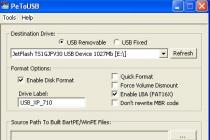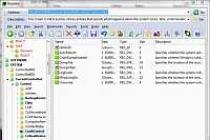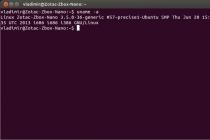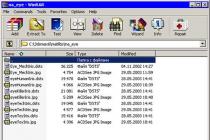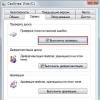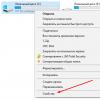The electrical panel in a private house, in a country house, in an apartment performs a dual function: it provides input and distribution of electricity and creates safe operating conditions. If there is a desire to understand not the simplest issue, you can assemble the electrical panel with your own hands. The introductory machine and the meter should be installed by representatives of the power supply organization, but further, after the meter, you can assemble the circuit yourself (although they do not like to lose money). True, before commissioning the house, you will need to invite them to be present at the start-up, check everything and measure the ground loop. All this - paid services, but they cost a lot less than a complete shield assembly. If you do everything correctly and according to the norms, it will turn out even better on your own: you are doing it for yourself.
What should be in the box
Both in an apartment and in a private house there are several options for the layout of the shield. This mainly concerns the installation site of the introductory machine and counter. In a private house, they can put a counter on a pole, and a machine gun on the wall of the house, almost under the roof. Sometimes the counter is placed in the house, but this is if it was built a couple of decades ago. V Lately metering devices are installed extremely rarely in the house, although there are no decrees and instructions on this matter. If the meter is located indoors, it can be placed in a shield, then when choosing a model of the shield, it is necessary to take into account the dimensions of the meter.
In some apartment buildings, meters are in boxes in the stairwells. In this case, the cabinet is needed only for RCDs and machines. In other houses, he stands in an apartment. When upgrading the electrical network, the cabinet will have to be bought in such a way that the meter fits there too, or buy a separate box for the meter with an introductory machine.

When drawing up a power supply scheme, safety is very important. First of all, it is provided for people: with the help of an RCD - a residual current device (pictured at number 3), which is installed immediately after the meter. This device is triggered if the leakage current exceeds the threshold value (a short circuit to the "ground" occurred or someone put their fingers into the socket). This device breaks the circuit, minimizing the possibility of electric shock. From the RCD, the phase enters the inputs of the automata, which also work when the load is exceeded or when there is a short circuit in the circuit, but each in its own area.
Secondly, it is necessary to ensure the normal operation of household appliances and electrical appliances. Modern sophisticated technology is controlled by microprocessors. im for normal operation a stable diet is required. After observing the voltage in our network for some time, you cannot call it stable: it varies from 150-160 V to 280 V. Imported equipment cannot withstand such a spread. Therefore, it is better to turn on at least some groups of machines that supply power to complex equipment through. Yes, it costs a lot. But during power surges, the control boards are the first to “fly”. They are not repaired by us, but simply changed. The cost of such a replacement is about half the cost of the device (more or less depends on the type of device). It's hardly cheaper. When assembling a switchboard with your own hands, or just planning it for now, remember this.

One of the examples of the layout of the shield for a small circuit is for 6 machines
A stabilizer is installed on one or several groups and is turned on after the RCD and in front of the group machines. Since the device is rather big, it will not be possible to install it in the shield, but please, next to it.
Also, two tires are installed in the shield: grounding and zeroing. All ground wires from instruments and devices are connected to the ground bus. The wire comes to the "zero" bus from the RCD, and is fed to the corresponding inputs of the machines. Zero is usually denoted by the letter N; when wiring, it is customary to use a blue wire. For grounding - white or yellow-green, the phase is led with a red or brown wire.

When assembling the electrical panel yourself, you will need to purchase the cabinet itself, as well as rails (called DIN rails or DIN rails) on which machines, RCDs and switches are attached. When installing the rails, check their horizontal level: there will be no problems with mounting the machines.

All machines must be interconnected. This can be done using conductors - connecting their inputs in series, or using a ready-made connecting comb. A comb is more reliable, although it costs more, but given the time you spend connecting all the machines, it is unlikely that a few tens of rubles are of such fundamental importance.

Scheme for several groups
Power supply schemes are not always simple: consumer groups are divided into floors, outbuildings, lighting of the garage, basement, yard and adjacent territory are taken out separately. With a large number of consumers, in addition to the general RCD after the meter, they put the same devices, only of lower power - for each group. Separately, with the obligatory installation of a personal protective device, output power for the bathroom: this is one of the most dangerous rooms in the house and apartment.
It is highly desirable to put protective devices on each of the inputs that go to a powerful household appliances(more than 2.5 kW, and even a hair dryer can have such power). Together with a stabilizer, they will create normal conditions for the operation of electronics.

Also not the most complicated circuit, but with a higher degree of protection - more RCD
In general, when designing an accurate circuit, you will have to find a compromise: make the system safe and not spend too much money on it. It is better to take equipment from trusted companies, but it costs decently. But the power grid is not an area where you can save.
Types and sizes of electrical panels
We will talk about cabinets / drawers for the installation of machines and other electrical stuffing, about their varieties. According to the type of installation, electrical panels are for outdoor installation and for indoor. The box for outdoor installation is attached to the wall with dowels. If the walls are combustible, an insulating material that does not conduct current is laid under it. When mounted, the external electrical panel protrudes about 12-18 cm above the wall surface. This must be taken into account when choosing a place for its installation: for ease of maintenance, the shield is mounted so that all its parts are approximately at eye level. This is convenient when working, but can threaten with injuries (sharp corners) if the place for the cabinet is chosen poorly. The best option is behind the door or closer to the corner: so that there is no possibility of hitting your head.

A flush-mounted shield implies a niche: it is installed and walled up. The door is on the same level with the wall surface, it can - protrude by several millimeters - depends on the installation and design of a particular cabinet.
Cases are metal, painted with powder paint, there are plastic ones. Doors - solid or with transparent plastic inserts. Various sizes - elongated up, wide, square. In principle, for any niche or conditions, you can find a suitable option. One piece of advice: if possible, choose a larger cabinet: it is easier to work in it, this is especially important if you are assembling an electrical panel with your own hands for the first time.

When choosing a building, they often operate with such a concept as the number of seats. This refers to how many single-pole circuit breakers (12 mm thick) can be installed in a given case. You have a diagram, it shows all the devices. You count them taking into account the fact that two-pole ones have a double width, add about 20% for the development of the network (suddenly buy some other device, but there will be nowhere to connect it, or during installation decide to make two from one group, etc.). And for such a number of "seats" look for a shield that is suitable in geometry.
Installation and connection of elements
All modern machines and RCDs have a unified mount for a standard mounting rail (DIN rail). On the back side they have a plastic stop that snaps onto the bar. Put the device on the rail, hooking it with a notch on the back wall, press the bottom part with your finger. After clicking, the element is set. It remains to connect it. They do it according to the plan. The corresponding wires are inserted into the terminals and the contact is pressed with a screwdriver, tightening the screw. It is not necessary to tighten it strongly - you can transfer the wire.
They work when the power is off, all switches are switched to the “off” position. try do not grab wires with both hands. Having connected several elements, turn on the power (input switch), then turn on the installed elements in turn, checking them for the absence of a short circuit (short circuit).

The phase from the input is fed to the input machine, from its output it goes to the corresponding input of the RCD (put a copper jumper). In some circuits, the neutral wire from the water is fed directly to the corresponding input of the RCD, and from its output it goes to the bus. The phase wire from the output of the protective device is connected to the connecting comb of the machines.
In modern schemes input machine put two-pole: it must simultaneously turn off both wires (phase and zero) in order to completely de-energize the network in the event of a malfunction: it is safer this way and these are the latest electrical safety requirements. Then the RCD switching circuit looks like in the photo below.

See the video for installing an RCD on a DIN rail.
After the required number of devices are installed on the mounting rail, their inputs are connected. As mentioned earlier, this can be done with wire jumpers or a special connecting comb. How the wire connection looks like, see the photo.

There are two ways to make jumpers:
- Cut the conductors of the desired segments, expose their edges and bend with an arc. Insert two conductors into one terminal, then tighten.
- Take a sufficiently long conductor, after 4-5 cm, strip 1-1.5 cm of insulation. Take the round-nose pliers and bend the bare conductors so that you get interconnected arcs. Insert these exposed areas into the appropriate sockets and tighten.
They do this, but electricians talk about the poor quality of the connection. It is safer to use special tires. Under them on the case there are special connectors (narrow slots, closer to the front edge), into which the bus contacts are inserted. These tires are sold by the meter, cut into pieces of the required length with ordinary wire cutters. After inserting it and installing the supply conductor in the first of the machines, twist the contacts on all connected devices. See the video on how to connect the machines in the shield using a bus.
A phase wire is connected to the output of the machines, which goes to the load: to household appliances, to sockets, switches, etc. Actually, the assembly of the shield is completed.
The choice of machines in the house or apartment shield
V electrical panel use three types of devices:
- Machine. Turns off and on the power in manual mode, and also works (breaks the circuit) in case of a short circuit in the circuit.
- RCD(safety shutdown device). It controls the leakage current that occurs when the insulation breaks down or if someone grabs the wires. When one of these situations occurs, the circuit breaks.
- Dif. machine(). This is a device that combines two in one housing: it controls both the presence of short circuit and leakage current.
Differential machines are usually put instead of a bunch - RCD + machine. This saves space in the panel - it is required less by one module. Sometimes this is important: for example, you need to turn on another power line, and there is no place for installation, as there is no free machine.

In general, two devices are often installed. Firstly, it is cheaper (differential machines are more expensive), and secondly, when one of the protective devices is triggered, you know exactly what happened and what to look for: short circuit (if the machine turned off) or leakage and possible overcurrent (it worked RCD). When the difavtomat is triggered, you will not find this. Unless you put a special model that has a checkbox showing what kind of malfunction the device worked on.
Automata protection
Circuit breakers selected by current, which is necessary for consumers of this group. It is simply calculated. Add up the maximum power of all devices connected at the same time in the group, divide by the mains voltage - 220 V, you get the required current power. Take the rating of the device a little more, otherwise, when all loads are turned on, it will turn off due to overload.
For example, adding up the power of all devices in the group, we got a total value of 6.5 kW (6500 W). We divide by 220 V, we get 6500 W / 220 V = 29.54 A.

The current ratings of the automata can be as follows: (in A) 6, 10, 16, 20, 25, 32, 40, 50, 63. The closest larger one to the set value is 32 A. We are looking for this.
Types and types of RCD
RCD has two types of action: electronic and electro-mechanical. The difference in price for a device with the same parameters is large - electronic-mechanical ones are more expensive. But you need to purchase them for a shield in a house or apartment. There is only one reason: they are more reliable, since they work regardless of the presence of power, and electronic ones require power to work.
For example, the situation is as follows: you are repairing the wiring, for example, a socket and de-energized the network for this - turned off the introductory machine. In the process, the insulation was damaged somewhere. If an electro-mechanical RCD is installed, it will work even if there is no power. You will understand that you did something wrong and will look for the reason. An electronic one without power is inoperable and turning on a network with damaged insulation can have problems.
To understand which of the devices is in front of you, it is enough to have a small battery and a couple of wires on hand. You supply power from the battery to any pair of RCD contacts. The electro-mechanical will work, the electronic will not. More about this in the video.
- type AC - alternating sinusoidal current;
- type A - alternating current+ pulsating constant;
- type B - AC + pulsating DC + rectified current.
It turns out that type B gives the most complete protection but these devices are very expensive. For a house or apartment shield, it’s quite enough, type A, but not AC, which are mostly sold because they are cheaper.
Except type RCD, it is selected by current. And in two ways: rated and leakage. Rated - this is one that can pass through the contacts and not destroy (fuse) them. The rated current of the RCD is taken one step higher than the rated current of the machine installed in tandem with it. If the machine is needed for 25 A, then take the RCD for 40 A.
In terms of leakage current, it is still simpler: only two ratings are put in electrical switchboards for an apartment and a house - 10 mA and 30 mA. 10 mA is put on a line with one device, for example, a gas boiler, a washing machine, etc. as well as in rooms where a high degree of protection is needed: in a nursery or bathroom. Accordingly, an RCD of 30 milliamps is installed in lines that include several consumers (devices) - on sockets in the kitchen and rooms. Such protection is rarely placed on the lighting line: there is no need, except perhaps on the street or in the garage.

RCDs are also different in time delay operation. They are of two types:
- S - selective - works after a certain time after the appearance of the leakage current (a rather long period of time). They are usually placed at the entrance. Then, in the event of an emergency, the device on the damaged line is first turned off. If the leakage current remains, then the “senior” selective RCD will work - usually this is the one that is at the input.
- J - also works with a delay (protection against random currents), but with a much smaller one. This type of RCD is put into groups.
Differential machines are the same types how RCD and are chosen in exactly the same way. Only when determining the power by current, you immediately consider the load and determine the nominal value.
For a few explanations on the installation of a built-in cabinet for a shield, the connection procedure, see the video from a practitioner and a generalist.
One important detail that is important for safety. On the RCD or differential machine there is a "test" button. When it is pressed, a leakage current is artificially created and the device should work - the switch switches to the “off” position and the line is de-energized. This is how the functionality is checked. This must be done at least once a month: to be sure of the reliability of protection. In turn, check all the RCDs in the circuit. It is important.
Probably, this is all the information that is needed to assemble the electrical panel with your own hands. Maybe you still need to learn more about how to split the load into groups, about this.
Conducting currents under normal conditions in the circuit and automatically cutting off the supply of electricity from the supply network to the consumer in the event of a short circuit or overload, you can also turn the circuit on and off manually.
The main difference between a two-pole automaton and a single-pole automaton is the presence of an automaton both in phase and at zero, that is, at two poles. Moreover, when disconnected, both the phase and zero are disconnected at the same time, thanks to the common cocking handle. It is used for installation of a single-phase circuit. For a three-phase circuit, 3- and 4-pole machines must be used.
Application area
- As introductory circuit breakers. This is the most popular application. With the simultaneous disconnection of the phase and zero, maximum safety is ensured when working in the circuit, because there is a complete blackout. In addition, according to the new rules of the Electrical Installation Device (clause 6.6.28, clause 3.1.18), the operation of single-pole automatic machines at the input is prohibited.
- To protect a separate group of electricity consumers. Disconnecting a two-pole machine will prevent operation - designed to protect against differential currents) in case of erroneous contact between zero and phase during repair work in circuits under load. It also facilitates the search for a branch with a malfunction when the RCD is triggered by current leakage to the ground.
- For protection and control of circuits with simultaneous power supply. For example, when a heat gun is connected, a phase is supplied to the heating elements through one pole of the machine, and a phase is supplied to the fan motor through the other pole. If one equipment is switched off, the other will be switched off, which will prevent the possibility of the heaters working without cooling.
Application advantages over single-pole machines
Consider a situation where someone mixed up the phase with zero. Then, when the single-pole machine is turned off, the zero line is disconnected, and the phase remains in the circuit. A person, thinking that he has secured himself by turning off the machine, starts working and receives an electric shock. To prevent this from happening, after turning off the single-pole machine, you need to check the absence of voltage in the circuit with an indicator. But it's still safer to use bipolar machine, which completely de-energizes the circuit.
In the case when the RCD has tripped, it is necessary to find a malfunction in the circuit. First of all, all electrical appliances from the sockets are turned off. If this does not work, the circuit branches are switched off in sequence, but both zero and phase must be disconnected. A single-pole machine does not provide such an opportunity. You will have to drop zero on the bus, which is problematic, since it requires a dial tone to find the right wire. A bipolar machine does an excellent job of this task.
So the benefits are:
- Safety - the electrical circuit is broken entirely.
- Ease of troubleshooting.
Disadvantages of using in front of single-pole machines
In fact, there are very few disadvantages:
- Cost - bipolar is more expensive than single-pole.
- Ergonomic - take up twice as much space in the electrical panel.
- Labor costs during installation - zero wires are not combined into a bus, but each is wound into its own machine.
- The impossibility of using standard distribution tires - "combs", instead of them you will have to use jumpers.
Machine device

The automatic switch represents the plastic case with contacts and the handle of inclusion/switching off. Inside is the working part. A stripped wire is inserted into the terminals and clamped with a screw. When cocked, the power contacts are closed - the position of the handle is "On". The handle is connected to the cocking mechanism, which, in turn, moves the power contacts. Electromagnetic and thermal splitters provide shutdown of the machine in case of abnormal circuit conditions. The arc chute prevents burning and extinguishes the arc quickly. The exhaust channel removes combustion gases from the housing.
Wiring diagram
It is proposed to consider the connection diagram of a two-pole machine.

Here VA 47-63 2/50A is an introductory two-pole machine. It completely de-energizes the entire circuit if necessary. A meter and an RCD are connected behind it. Next, a row connection diagram is applied. They are installed only on phase wires, and the neutral wires are distributed via the bus.
There is a scheme for connecting a number of two-pole automata, each protecting its own branch.

The RCD is connected first at the input, then two rows of two-pole switches. The neutral wire is marked in blue, the phase wire is red, and the ground wire, distributed using a ground bus, is yellow. Thus, each branch of the circuit is protected.
Installation
How to properly install circuit breakers in the electrical panel? First, din-rails are screwed into it with self-tapping screws - these are metal plates, on which all automatic machines and RCDs are then attached. The length of the DIN rail can be adjusted with a hacksaw. In addition, distribution terminals-tires are attached to the shield. They can be for and separately for grounding. The modern busbar configuration allows you to mount them directly on the DIN rail.
Installing a two-pole machine on a DIN rail is very simple. With a flat screwdriver, you need to pull out the snap-in bracket on the top of the case, attach the machine to the DIN rail and release the mount. Removal is also carried out. According to the rules, the introductory machine is installed in the upper left corner.
Next you need to connect the wires. You should strictly adhere to the scheme. The input wires of the phase and zero are connected to the two-pole machine from above, and the wires are led into the circuit from below. It is important not to confuse: the entrance is from above, the exit is from below, otherwise the machine may fail and will not perform its functions.

The machines can be connected using jumpers made of copper wire of the same cross section as the circuit wire. Jumpers are required to connect two-pole machines in a row. And also with the help of combs - these are insulated tires, used to connect single-pole machines.
The ends of the wires are stripped using a special stripper tool or a sharp knife. Then they are crimped with cable lugs with a crimper hand tool. If there is no such equipment, then you can simply tin the ends with a soldering iron using rosin and tin. When connecting wires to machines, it is necessary to tighten the bolts tightly with a screwdriver so that weak contact does not cause heating and damage to conductive materials.
The ground wire always passes by the machines straight from the ground bus. Zero wires are connected to the zero bus.
Marking
Particular attention should be paid to the marking of machines.

Special markings are applied on the body of the machines:
- The rated current of the device (in amps).
- Overload current group (operating current range).
- Maximum operating current or short circuit current (in amps).
- Current limiting class (the higher the class, the higher the response speed in case of a short circuit).
- Graphic designation or circuit diagram device.
- Apparatus series.
- Rated voltage at which the machine must be used.
Machine selection
I - rated current in amperes "A".
P is the power of all devices (the sum of powers) in watts "W".
U - mains voltage in volts "V" (basically, you need to select the machine with the nearest higher value of the rated current.
Also, the choice of the machine according to the value of the long-term permissible current should be made, depending on the characteristics of the wiring cable. The rules for the installation of electrical installations contain tables of calculations. The larger the cable cross-section, the higher the permissible continuous current.
Content:Circuit breakers, called automata or switches in everyday life, refer to the means of switching and are intended to supply electric current to an object. The main function of these devices is automatic shutdown power supply in the event of an emergency and network failures. The machine protects the electrical circuit from short circuits, overloads and voltage drops beyond the permissible value.
In old houses, in the power supply system, the neutral wire was not only a working one, but also performed a protective function at the same time. In modern buildings, a clear separation of the purpose of working and protective conductors is provided. In this regard, the question often arises of how to connect a circuit breaker, since all European-style electrical installation products are equipped with terminals for connecting a ground wire. In addition, the fastening of the machines themselves in the switch cabinet can be done by mounting on a DIN rail or on a special mounting panel.
Device and principle of operation
Before connecting the machine, it is necessary to understand the features of its design and the principle of operation. The circuit breaker consists of a housing, a switching device, a control mechanism in the form of a button or a handle, an arc chute and screw terminals located at the top and bottom.
For the manufacture of the body and the control mechanism, durable plastic is used that does not support combustion. The switching device consists of moving and fixed contacts. Each pole of the machine consists of a pair of these contacts and is equipped with its own arc chute.
The purpose of the arc chute is to extinguish the electric arc that appears when the contacts are broken under the action of the load. The chamber itself is made in the form of a set of steel plates with a profile of a certain shape. They are isolated from each other and located at the same distance relative to each other. It is to these plates that the arc is attracted, which here cools down and dies out. Number of pairs of contacts in different models automatic machines ranges from 1 to 4. The devices have position indicators. Red indicates on, green indicates off. Thus, one can very quickly determine Current state circuit breaker.
All parts are hidden inside the case, only the upper and lower screw clamps, control handle and indicator are visible from the outside. There is a latch on the case that allows you to quickly install the machine on and just as easy to dismantle it.

To turn off the machine, there is a special mechanism called a release. Each type of release has its own design. For example, in conventional machines, the function of a disconnecting device is performed by a coil with a winding and a core. For winding, copper insulated wire is used. The inclusion of the coil in the electrical circuit is carried out in series with the contacts, since it is through it that the load current moves. If this current exceeds the set permissible value, then under the action magnetic field coil core moves and exerts a mechanical effect on the disconnecting device. As a result, the contacts of the circuit breaker open.
The design of the thermal release has its own characteristics. It includes a special bimetallic plate. For its manufacture, two types of metals are used, heterogeneous in composition and with different coefficients of linear expansion. The plate is connected to the circuit in series with the load. During the operation of the machine, it is heated by the current passing through it. In case of overload, the plate bends towards the metal with the lowest expansion coefficient. The trigger mechanism comes into action, turning off the machine. The greater the current exceeds the rated value, the faster the thermal release trips.
Installation of circuit breakers
The connection of circuit breakers in the switch cabinet is carried out in a certain sequence. From above, a cable is connected to an external current source, and through the output holes located below, the wiring is routed to its objects, in accordance with the electrical circuit.

At the beginning of the installation, an introductory machine is connected. If there are several lines in the circuit that are isolated from each other, they are separated from the introductory circuit breaker. Its power must not be less than the total power of the machines connected to separate lines. For this purpose, two- or four-pole devices of group D are selected that are resistant to the inclusion of power tools and other powerful equipment.
The most widely used, suitable for any power supply schemes for apartments and private houses. Modular circuit breakers are mounted on a DIN rail and connected by conductors with a current carrying capacity exceeding the operating current of the circuit breaker. A more convenient connection of several machines in one row can be performed using a special connecting bus. A piece of the required length is cut off from it and fixed in the terminals. Such a connection is possible due to the distance between the bus contacts, corresponding to the standard width of the modular machines. The switch is installed on the phase, and the neutral conductor is supplied from the input device directly to the devices.
- single pole the switch is used in the installation of sockets and lighting systems.
- Bipolar machine suitable for appliances increased power such as an electric stove or boiler. In case of overloads, it is guaranteed to break the circuit. The connection diagram of such switches is practically no different from single-pole models. For more efficient use, it is recommended to connect them to a separate line.
- Three-pole the circuit breaker should be installed only in cases where it is planned to use electrical appliances operating at a voltage of 380 V. In order to exclude, the load is connected according to the "triangle" scheme. This connection does not require a neutral conductor, and the consumer is connected to his own switch.
- four-pole the circuit breaker is most often used as an input. The main condition for connection is the uniform distribution of the load on all phases. When connecting equipment according to the “star” scheme or three separate single-phase wires, excess current will flow through the neutral conductor.
With a uniform distribution of all loads, the neutral wire begins to perform a protective function in case of unforeseen power imbalances. To ensure a normal connection, only high-quality materials should be used. All connections must be securely fastened to the terminals. If several cables are connected at once, their contacts must be carefully cleaned and tinned.

The procedure during connection can be considered using the example of a two-pole circuit breaker installed in a shield. First of all, the electricity is turned off in order to completely de-energize the network. The absence of electricity is checked with an indicator screwdriver or a multimeter. Then the machine must be installed on a DIN rail and snapped into place. The absence of a mounting rail can create certain inconveniences. After that, the cores of the incoming and outgoing wires are cleaned to a distance of 8-10 mm.
Introductory wires are connected to two clamps located on top -. In the lower clamps, similar outgoing conductors are fixed, distributed to sockets, switches and electrical appliances. All wires are qualitatively clamped in the terminals with screws. The connections must be checked manually. To do this, the conductors must be gently moved from side to side. In the event of a poor-quality connection, the core will stagger in the terminal and may even jump out of it. In this case, the terminal screw must be tightened.
Upon completion of installation, voltage is applied to the network and the operability of the circuit breaker is checked.
How to choose the right machine
Of great importance right choice automatic switch. Each device has its own parameters, such as rated current, network operating voltage, number of poles, maximum short-circuit current, time-current characteristic and other important values.

The operating time of the device has a digital designation indicating at what current the normal operation of the circuit breaker is maintained. At home electrical networks most often used machines with numbers 4500, 6000 and 10000 amperes. Everything specifications are indicated by the manufacturers directly on the device case. This also includes a wiring diagram, as well as symbol machine.
The main criteria for choosing a circuit breaker is the load power and the cross section of the wires used. In addition, the overload current and short-circuit breaking current are taken into account. As a rule, network overloads occur when devices and devices with a total power are turned on at the same time, causing excessive heating of conductors and contacts. Therefore, the tripping current of the machine installed in the circuit must be greater than or equal to the calculated one. Its value is defined as the sum of the capacities of all devices used, divided by 220.

The short-circuit tripping current also causes the machine to trip. It is selected by calculation for a specific circuit and depends on the loads used most often. In order to improve protection, they can be included in the electrical circuit.
Errors when installing the circuit breaker
When performing electrical work, serious mistakes are sometimes made that can lead to negative consequences in the course of further operation.
- The power cable is connected from below. Although this is not prohibited by the PUE, such a scheme will be inconvenient, since the installation and placement of machines in the shield is designed specifically for the top connection.
- A common mistake is to over-tighten the pins with the set screws. This can lead not only to damage to the core, but also to deformation of the body of the product.
- Sometimes the wires are connected incorrectly. It is necessary to pay attention to the marking, connect the phase and neutral wires located on top with the same wires located below.
- In some cases, one two-pole machine is replaced by two single-pole ones. This is absolutely impossible to do, since they do not provide simultaneous separation of the phase and zero.
- Often, during the fixation of the core in contact, the insulation enters the seat. This leads to a weakening of the contact, resulting in overheating of the core and other negative consequences. Therefore, it is imperative to protect the wire in accordance with the technical requirements. specific model machine. This operation must be carried out using a stripping tool.
A negative role can be played by the wrong choice of the circuit breaker, which subsequently is not able to withstand the planned loads. Therefore, it is recommended that you first perform all the necessary calculations, especially. It should be remembered that when calculating the value of the automaton should be rounded down. For example, with a current load of 20 A, the circuit breaker should be selected at 16 A, which will significantly increase the life of the wiring.
To understand how to connect the machine in the shield, you need to familiarize yourself with the minimum requirements for electrical safety, fire protection. Also, knowledge of the basics of electrical engineering will be needed to calculate the required load from electrical appliances. It is important to choose the type of electrical appliance, the rating of its operation and the number of safety devices.
Purpose of electrical protection
To understand how to connect the machine in the shield, you need to familiarize yourself with its purpose and types. The electrical panel houses all the equipment for distributing power to household appliances. There are terminal blocks, an electricity meter, automatic machines, relays.
The equipment is held by a din rail made of conductive material and grounded at one point. They try to place the electrical panel at the entrance to the apartment or from the street side in a private house. The machine itself belongs to complex technical devices. Certain requirements are imposed on it, depending on the purpose of the device.
A modern meter machine protects wiring, equipment from short circuits and can even save people from electric shock. It is forbidden to make home-made fasteners for the device in the shield in order to comply with safety rules when working in live devices. How to connect the machine in the shield, knows a specialist who has the appropriate tolerance group. But if contacting the master is expensive, and not profitable, then you can replace it yourself.
In most cases, electricians provide a standard scheme for connecting live wires - from above. However, often the box for the meter is mounted by specialists who are not related to electricity, and they bring the phases from the bottom of the machine. Therefore, before replacing failed devices, it is imperative to measure the voltage supply with a working voltmeter.
General information
The box for the meter in the apartments contains a two-wire circuit for connecting electrical appliances. It is simple and contains a supply wire - "phase", and a discharge wire - "neutral" or "zero". Modern regulations provide for the use of "grounding" to protect against short circuits. Devices such as washing machine, refrigerator, electric oven, must be connected in a three-wire circuit.
The designation of the earth wire is common - yellow-green stripes. To connect the machine, it does not matter which terminal the phase wire will be connected to. But it is recommended to bring it from above so that the next inexperienced specialist does not fall under the influence of the current, grabbing the wire from the bottom of the machine out of habit. Before any work, it is required to turn off the input switch, but many electricians perform work under voltage.

Wiring and connection must be carried out by a specialist with the appropriate education and approvals. Dealing with the nuances of installing some machines is not easy, especially if the consumer decides to install a separate switch for each socket and light bulb. Some organizations can provide a ready-made electrical panel assembly. But in this case, it is necessary to provide for the possibility of installing additional machines in the future, if you wish to change the overall electrical circuit.
To install and connect the machine, you will need:
- Tools: wire cutters, flat and Phillips screwdrivers, multimeter.
- A wire designed for the household appliance used, the cross section should be twice the load. Installation is carried out in an already installed shield, so the din-rail is not taken into account.
- The machine must have standard mounts. The wires are laid in a corrugated hose to protect against mechanical damage.
The insulation is removed from the cable, the length of the stripped wire is selected no more than 10 mm, so that the bare parts are out of reach for the hands and do not touch the metal parts. Grounding is recommended. In old houses, it may be absent altogether. But for your own safety, you need to install it.
To connect the "ground" in the shield, a common open terminal block is used for each supply wire. The outlet conductor is one of a larger cross section. "Neutral" is also recommended to be performed with one block, but of a closed type. It often has a potential that is dangerous to human life. starts by connecting the ground wire, then the neutral. At the end, a phase is put.

If there are several machines, jumpers are used, which begin to be set from the introductory switch. A hose corrugated inside the shield is only needed for non-standard cable laying, when there is a risk of damage to it. Corrugation is not applied to short sections.
Jumpers are replaced by a common distribution plate, available from any electrical store. To protect the contacts from touching, a box for an automatic machine made of plastic or other dielectric is used.
Device selection
The load on the machine must be less than the calculated one. 10, 16, 20 amps are in demand. A higher denomination is usually placed under boilers, house heaters, and ovens. For standard appliances, 10 amps are suitable: PC, TV, iron or hair dryer. However, if several loads can be connected to one device, then the resulting value is obtained by adding all the ratings.

It is not recommended to use many devices, sockets, lighting lamps for one machine. If one link fails, the socket can fuse without turning off the fuse. So a 2-amp household appliance can start to consume 5 amps if there is a malfunction in the board. A 16 amp machine will not work. Even the insulation on the wires can melt.
Therefore, before choosing a machine, it is recommended to consult an electrician on the choice of the type of protective device. They differ in response speed, purpose of protection, connection, internal device, number of phases. For mounting in a shield, the phase wire is supplied from the side of the fixed contact, the marking is often already indicated on the body of the machine.
Switch types
The device of the circuit breaker depends on its type: the response speed can be milliseconds for magnetic switches and several hours for machines with a bimetallic plate. The letter in the designation matters when choosing a protective device. For a house, it is recommended to set types B, C.
Classes Z are rarely found in everyday life (for electronic devices), D (for electric motors and inductances), A (for extended conductors). Experienced electricians recommend combining machines with or using difautomats. Distinguish between electromechanical and electronic protection. The second one is less reliable and quickly fails, tracks and internal elements burn out during significant overloads.

When choosing the type of machine, it is recommended to take into account that the current rating through the wiring section must exceed the possible overload and the maximum value of the circuit breaker. If the machine has high speed actuation and sensitivity, then it will have a higher value. However, it will not be reliable in all cases, erroneous responses to an increased load are possible.
It is possible to identify such a problem only in each specific case when analyzing the type of household appliance and additional parallel loads connected simultaneously to the network.
Design features
The circuit breaker device is of the following types:
- Electronic principle of operation.
- Electromechanical.
- Electromagnetic.
For the home, budget options for the execution of machines are more often chosen. electromagnetic principle actions. The main working part is a bimetallic plate. It is advisable to choose a switch in proportion to the cost of equipment. For normal functions conventional machines are suitable, but if a specific electrician is used, it is recommended not to save on protective equipment.
Fuses are used in production to this day in especially critical nodes of the electrical circuit. RCD mainly protects the human body from electric shock. From the basics of electrical engineering, it is known that the current in a series circuit is the same. The principle of operation of the device is based on comparing the current of the phase and neutral wires. The so-called arising at the moment of defeat of the person comes to light.

However, RCDs can often trip erroneously when operating large inductances or capacitances. The operation of the machine is not affected by the method of connecting the phase and neutral in a single-pole version. The overload is measured, the potential difference is not taken into account.
Common Mistakes
Upon completion of the work, we received the installation in which it was completed in accordance with all the rules. But the machine still knocks out for no apparent reason or the equipment in the house does not work. Such a result is possible with the erroneous execution of some points.
A simple and solvable problem is the lack of contact in the terminals of the machine. This is possible if the wire insulation is not sufficiently removed, when the clamping jaws get on the dielectric part. The bare end should protrude slightly beyond the limits of the machine, and they should be protected by a dielectric case worn over the switch.
Suppose that the shield in the apartment has a non-standard connection scheme, and during installation they could put the neutral of the devices on the ground conductor. This type of malfunction occurs only for beginners, but it can lead to the failure of an expensive device: TV, PC, charger or other type of equipment.
Burnout of the pads can occur when powerful devices are connected to the network, when the wire core on the machine is not stretched and has a weak contact. From a heavy load, a spark breaks through, as a result, the device heats up in this place, but does not knock out. Prolonged operation in this mode leads to the fact that the plastic begins to melt until it ignites or short circuits to a grounded case.
Arises typical mistake when the cross section of the connected wires differs slightly. In this case, loose contact is possible, due to which a spark will break through. Ultimately, this will end with the result described above. To avoid a fire, a non-flammable switchboard is needed. Electrical installation is erroneous when connecting several sources of different power to one machine. The higher the difference between the most powerful device and the weakest, the less reliable contact is obtained in the sponges.
Ease of installation is achieved by forming the wires in the form of a Y-shaped arc at the connection point. This makes it easier to hold the conductor while tightening the terminal. Before making the connection, be sure to turn off the main switch, if possible.
To connect the machines, you can use your own jumpers of the same section. but best solution there will be a common tire with standard mounts. When tightening solid wires, there are no questions, but difficulties are possible when using stranded conductors.
It will be necessary to carry out the termination of the cores before tightening into the terminal. For this, a special crimping device is used, which can be bought at electric stores. Standard sections are marked on its jaws, choosing the appropriate part, they achieve the best contact after the compression procedure. A smaller diameter will lead to a partial break of the cable, and a larger one will not give the desired result.

For crimping, special lugs for a specific wire diameter can be used. There is a second method - soldering. It is longer, but less reliable and is used in low-power circuits. The joint is soft. At first, the terminals will be tightened to the maximum, but after some time they will loosen due to the fact that the solder will begin to “float”. Bad contact can cause a fire.
What should not be done?
Often used in old buildings and new connection schemes have copper conductors. Inexperienced electricians can connect two metals in a twist, which over time can result in a replacement of the wiring. This is due to a chemical reaction between two different substances: aluminum and copper.
An oxidative process occurs, the rate of which depends on the load in the given circuit. If such a connection is necessary, then installation can be done through insulated terminal blocks. However, after a long time, the bolts will have to be stretched, they will loosen. Twists are not recommended for use in the shield. And it is better to sign each machine, in a few years you can forget about the purpose of the device.
You can reduce the load on the machine by using economical household appliances and lighting lamps. This approach will allow you not to think about the possibility of melting the insulation. The only risk left is a short circuit.
In the event of a malfunction
If the machine is knocked out, it is not recommended to turn it on immediately. First you need to evaluate possible cause malfunctions: a recently hung shelf, a new purchased appliance, or the absence of previous events. Overload could occur due to the burnout of part of the wire in monolithic structures. To find a problem area, there are devices available to electrical specialists. This is true when the cost of opening the wall is much higher than the cost of diagnosing electrical equipment at home.
When the machine knocks out, it is recommended to use an ohmmeter and check if there is a short circuit to the ground or between the conductors: phase and neutral. Before that, turn off all household appliances. Inclusion in the circuit is carried out by one device, while measuring the current through the wire using electric clamps.
Exceeding the load rating of the machine requires either replacing the switch itself, or changing the place of its connection. When diagnosing, you can check the wire with your hands without measuring device, holding the insulation during the operation of consumers. If it heats up, then there is an overestimated current in the circuit.
The question that worries every caring owner is how to properly and safely connect the machines in the electrical panel. The process, of course, is subtle, but at the same time it is easy to do. Power must be connected to the top contacts. These are the general safety rules. DIN rails are installed in a free place - this is a metal profile that is used in electrical engineering for fastening. The location on the rail is not critical to the operation of the equipment.
Called modern modular systems protection, which are designed to protect electrical appliances from the dangerous effects of electric current. Can be distinguished:
- protective shutdown device;
- switch;
- differentiated device;
- protective relay.
Automata are different, but they serve the same purpose.
These are the main varieties that are used in everyday life to turn off electrical energy in the event of:
- if a current of higher voltage began to flow through the circuit than that for which the system was designed;
- a short circuit has occurred.
Before studying the connection of machines in the shield, it is important to understand that a large amount of electrical equipment is installed in modern houses and apartments. If the network fails, expensive refrigerators, microwave ovens, electric ovens, washing machines etc. If
Electric machines: how to choose a quality
Installation is a secondary matter.
Before you connect the machine in the shield, you need to purchase it. Experts say: the choice of a unit that is excellent in terms of characteristics is 80 percent of success in its operation.
What to focus on:

High-quality RCD is certified and licensed
- For the price. Don't skimp on equipment. This is the thing that is installed for many years. It is advisable to choose a proven brand that has proven itself well in the market.
Among the leaders are manufacturing companies EKF, IEK, Merlin Green, ABB. If the price is less than 500 rubles, the product is not worth buying.
- For frequency and rated voltage. Choose one that is designed to operate current at a frequency of 50 hertz. It can be operated in single-phase and three-phase circuits as desired. This option can be called optimal for use in a single apartment or private residential building.
- The value of the rated current. It tells the owner how much current (in amps) can flow through the device regularly. If the value is exceeded, then there will be a power outage in the selected section of the circuit.
- Poles (number). Do-it-yourself connection of automatic machines in the shield is possible to single-phase and three-phase network. We have already mentioned this. If one or two poles, then you can connect it to a 220 volt network, if three or four, then to a 380 volt network.
- The number of poles is equal to the number of places for devices. Knowing this principle, it will be easier to understand how the circuit for connecting machines in the shield works.
Connection: required tools
It is not possible to connect the equipment with bare hands without any additional devices. In order to connect to the network, you need to have at least the following tools:
- indicator screwdriver;
- stripper for removing insulation;
- wire cutters;
- various pliers;
- screwdrivers;
- crimper for crimping lugs (if stranded wires are used).
Any circuit breaker is mounted on a DIN rail. Its width is standard - 3.5 centimeters.
How to connect correctly: the order of work
You have already chosen the device, stocked up with the necessary tools, which means that you can install the machines in the shield. If you follow a strict sequence and all safety measures, then the procedure will pass quickly enough and safely for the health and life of the installer himself. The work order looks like this:
- de-energize the electrical panel. Check if there is no electricity with an indicator screwdriver;
- make sure that there is no unexpected power on;
- snap the equipment onto the DIN rail;
- take care of a secure fit. He must not move;
- if the pole is one, then the phase of the circuit comes out of the terminal from the bottom, and the phase of the device comes out of the terminal at the top;
- if there are two poles, then the same phases are applied to the terminals at the top and bottom left, and zero is applied to the right to the lower and upper terminals. This is how the zero tire in the shield is determined;
- if there are three poles, then the input and output of the phases must be determined in a clear sequence. Oriented according to the letters of the Latin alphabet, which are applied from below and above: A, B, C or L1, L2, L3 (depending on the unit itself);
- if there are four poles, then the additional terminal serves for zero;
- electricians' opinions on how to properly connect the machine from above or below are sometimes divided. Experienced experts advise attaching incoming lines from above, and outgoing lines from below. This is a generally accepted system that will help to avoid an emergency when replacing equipment in the near or distant future;
- when connecting, there should not be kinks on the cables, in which case the system will not work normally, failures, inaccuracies are possible;
- excess parts of the power lines must be removed with wire cutters;
- then you need to remove the insulation from the end of the cable, if any;
- if the cable is stranded, then the lugs must be terminated. These are the requirements of elementary safety;
- check the correct connection and reliability of fixing on the DIN rail;
- fit the cable into the terminals and secure with a screwdriver. Overtightening can be dangerous to the unit. Zealous in this case is not worth it;
- apply voltage;
- check if there is voltage. You can organize a check using an indicator screwdriver.

It is important to connect the machines in series so as not to disrupt the network
You can connect according to the schemes:
1) counter - unit - consumers;
2) counter - group unit - switch - groups of units - consumers.
In the first case, when the device is triggered, the entire network will be turned off, in the second, only a specific part of it, where the emergency occurred.
The main mistakes of novice electricians
Not often, but it happens that the auto switch after installation does not fulfill its "professional duties". We have already figured out how to put the machine in the shield, now it is important to understand why he does not want to work. Common installer errors include:
- The insulation has come into contact. Insulation from electrical wires must be removed without fail; if this is not done, then there is a possibility of a short circuit. At least failure in this case is guaranteed.
- Connection of several conductors with different cross-sections to one terminal. This happens when it comes to connecting a group of units. In this case, it is advisable to use jumpers between devices and cables so that there is no confusion. Jumpers must be made from a cable similar to the section wires. This will help to avoid premature flashing of jumpers and fire.
- An attempt to form the ends of the veins. The bare part of the line must be bent with the letter U before being inserted into the terminal. The area of \u200b\u200bcontact of the wire with the surface will increase, the performance of the device will increase, and the contact will become more reliable.
- Connecting a wire with several cores to the unit without termination. The exposed cores will be crushed, they will not be able to work normally.
- Soldering a cable with several cores. This is not recommended due to premature wear of the cores in the future.
How to install the machine in the shield: safety rules
When installing in a shield, there are features. You cannot work with bare hands. It is important to protect yourself by wearing special protective gloves.
Often, those who install the unit on their own are interested in how to connect the machines after the meter. In fact, the process is no different from placing equipment up to the meter. Connection can be made in two ways. The main thing is to strictly follow the order and de-energize the electrical panel until installation.
Another controversial issue is the connection of the machine in the shield from below or from above. You don't need to reinvent the wheel. In the world of electricians, the rule is: entry - from above, exit - from below. If one person installs the device incorrectly, another person may end up in a hospital bed due to such negligence! Therefore, it is necessary to act strictly according to the principle.
There should be no problems with how to connect a single-phase circuit breaker. The unit has one or two terminals at the top or bottom. The top left ones are designed for current input and output, the right ones are for zero.
The installation of the machine in the shield is shown in the following video:
During operation
What to do if the unit has worked? How to reconnect the circuit breaker? It is not necessary to remove from the DIN rail. But it's also not worth turning it on manually either. It is important to understand why the device responded? What is the reason?
You can turn it on again no sooner than after 10 minutes so that the device can cool down and recover.
The unit can work with the simultaneous operation of a large number of household appliances in an apartment or house. To protect the network from overvoltage and short circuit, the switch performs its functions. How to calculate the load on the machine? The maximum voltage is indicated on the equipment itself. You need to calculate how much electricity household appliances consume in the aggregate, and compare this figure with the one indicated on the auto switch. How to calculate the amperage of the machine? For example, washing machine, air conditioner and electric stove together they consume about 450 amperes, while a differential device can only pass 400 amperes. This means that when connected to the network at the same time, an operation will occur.

The work of an electrician must be safe
Emergency operation may occur in hot weather. This is extremely rare. But there is a possibility. If the place heats up too much, then the additional thermal energy will “confuse” the unit. Most often this happens if the equipment is too old, does not meet modern requirements. Therefore, before connecting the circuit breaker, make sure that the electrical panel itself meets modern requirements and standards. If this is not the case, then before connecting the machine to the wiring, take care to replace the old shield with a new one. There shouldn't be any problems in this case. There is no shortage in this area.
Finally

Machines in the shield must be arranged in strict order
Strict adherence to connection technology should be fundamental in the installation. To the question of how to connect a packet machine, the answer will be the same - most importantly, it is safe. Wrong installation can lead to a fire and breakage not of a single device, but of the entire electrical circuit and a large number of household appliances. To avoid such troubles, it is enough not to rush, to perform actions consistently, using quality tools.
You can learn more about the installation from the video:

